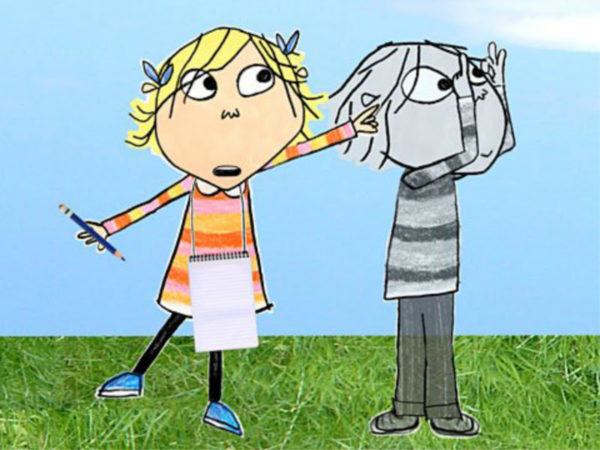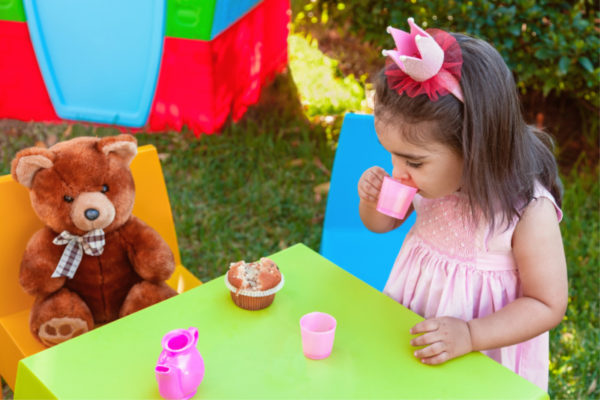Make-believe buddies: 8 common questions about children’s imaginary friends

Does your child talk to someone who isn’t there, or make you set a place at the table for their teddy bear? They probably have an imaginary friend. If you’re not sure how to handle it these eight common questions parents ask will have you covered.
1. What is an imaginary friend?
Imaginary friends are pretend-pals that your child invents using their imagination. Often they take the form of something physical such as a doll, teddy or toy; however, sometimes they’re completely invisible – just like Lola’s buddy Loren Sorenson on Charlie and Lola, or Milco the invisible friend Kate Ritchie’s character Sally Fletcher had on Home and Away. Interestingly, producers actually made Milco into a real character (her brother) many years later, which raises the point that invisible friends aren’t always made up. They can also be based on real people who just aren’t there in the flesh at that moment, or be characters from books and movies. Children can also have more than one imaginary friend too.

2. When do they appear?
The earliest they can start to occur is around the age of two and a half. However, they may develop later than this. And while some imaginary friends are always present for the child, others might come and go depending on the situation – such as only materialising in specific places or times, like their bedroom or Grandma’s house.
3. Is it normal to have one?
Absolutely. Two in three children will have one at some point, especially around preschool age, so rest assured there’s nothing ‘wrong’ with your child. In fact, it’s a routine part of healthy childhood development, and even better yet, children with make-believe mates can often become more social and imaginative and show more empathy when playing with other kids – which helps them be a more considerate and caring adult.

4. Why do children create them?
Each child is different, but some of the reasons he might invent a friend include:
- Bored or lonely – Kids who are the eldest or who have no siblings are more likely to have imaginary friends.
- A coping mechanism – It can be a form of self-soothing to help children adjust to a life transition period such as moving to a new home or preschool, a sibling being born, or their parents getting a divorce.
- Children enjoy being creative – Perhaps they’re not getting imaginative play from any other sources or they might simply just love fantasy stories and everything magical and make-believe. It’s a chance for them to explore a world they’ve created.
- Kids like being in control – A child can decide when and where their imaginary friend appears and what they say and do, allowing them to be in charge for once. For him, it’s like being a parent, teacher or bossy older sibling for once instead of always being told what to do.
- Fulfils other needs – A child’s imaginary friend will always play with and support them, never judge or find fault with them and listen to whatever they have to say. These friends are unique, can do many things they can’t do themselves, and belong only to them.
Read more about children’s imagination:
- Take little imaginations in fresh directions with Story Stones
- ‘Max & George’ – a story about imaginary friends
- The Beanies’ new podcast series will spark your child’s imagination
5. Do children know their friends aren’t real?
Yes! According to Kimberly Eckert, a registered psychologist in Calgary, creating and sustaining an imaginary friend is a sophisticated cognitive skill, and kids are very aware that it’s pretend play – i.e. they know the difference between real life and fantasy.
6. How do I act around my child’s ‘friend’?
You should never discourage your child’s make-believe friend or make him feel silly or ashamed about it. This could be damaging emotionally, plus imaginary friends can actually be helpful to parents by giving them a lot of insight into their child’s feelings, likes and dislikes.
Sometimes they can be a bit problematic though too, so it’s best to know how to handle these situations when they arise. Some examples include:
- Do things for their friend – Such as holding open doors or making extra snacks. Encourage your child to do it themselves or help you with the task, so you’re not excluding the pretend friend but are also developing your child’s skills.
- Speak through their friend – Some kids want everything to go through their made-up friend, asking you to speak to them instead of you or not answering a question until they’ve discussed it with their pal which can be super frustrating. If it gets too much to handle, tell your child you want to speak to them and not their friend.
- Someone to blame – Often, imaginary friends get the blame for something a child has done themselves (such as make a big mess or break something valuable) which is never acceptable. Calmly explain why that’s not possible and ask them to help you rectify the problem.

7. Do they ever go away?
In most cases, imaginary friends only last for several months but they can remain for up to three years. Generally, they will disappear once your child is ready to move on to a new phase such as starting school, where toys from home often aren’t allowed and real friends are more accessible and socially accepted.
8. When should I be concerned?
Imaginary friends are generally nothing to worry about, but if your child is getting older and their ‘friend’ is preventing them from socialising normally, then it could be worth looking into further. In rare cases, imaginary friends are also symptoms for more serious issues, so if your child has witnessed something traumatic or their ‘friend’ is being mean and hurtful to them, then it’s best to speak with your doctor for advice.
Does your child have an imaginary friend? Share your stories with us on our Facebook page.









